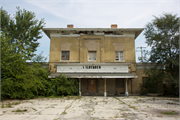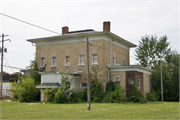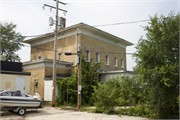| Additional Information: | A 'site file' exists for this property. It contains additional information such as correspondence, newspaper clippings, or historical information. It is a public record and may be viewed in person at the Wisconsin Historical Society, State Historic Preservation Office. Photo codes are 13-3/6 and 13-3/7.
Additional Comments 2024:
Architecture:
The Nunnemacher house is a two-story building with a two-story square form and projecting one-story wings. The building is constructed of cream brick and has features of the Italianate style. The main block has a hip roof with wide eaves decorated with a wide frieze and modillions. The main entrance is accented by a two-story, very shallow, brick surround. The entrance is covered with plywood and features a glass block surround, a heavy stone round arch with a keystone over a fanlight transom. A large overhang covers the main entrance. It is supported by metal posts sitting on concrete bases. The roof is topped with a mansard section that is clad with aluminum siding.
Most of the openings of the house are altered. On the second story, the original openings have been enclosed with tan bricks and smaller single-light sashes and decorative lintels have been removed. Most openings of the first story are partially enclosed, as well, but there are a few original openings filled with paired four over four light, tall, narrow, sashes that are paired.
The views of the interior of the house show that it has a large amount of modern drywall surfaces and modern materials covering original or period floors. But, there are a few original or period details that are extant and they include the main entrance that sits behind the boarded-up entrance. This entry features an arched opening with sidelights and a fanlight transom along with wood panels. The main staircase with its walnut balustrade and newel post is extant, as is a later-added narrow board patterned floor, a marble fireplace, and some wood trim around doors and windows. The interior is in poor condition.
History:
Jacob Nunnemacher came to Milwaukee in 1843 and opened a meat stall in an old public market, the site of today’s Milwaukee City Hall. After the market was razed in 1860, Nunnemacher built a commercial building for his meat market. In 1853, he acquired 120 acres of land at this location, built a distillery on the property, which he rebuilt in 1857 after a fire, and, according to various sources, built this house around 1856. Nunnemacher operated a farm on the property where he grew grain and raised livestock. He acquired another 200 acres of land in 1862 and an additional 160 acres in 1866, creating a large farm where he raised hundreds of head of livestock and continued to operate the distillery. There were many outbuildings on the property, but all have been long demolished.
During the 1860s and 1870s, Nunnemacher got in trouble with the federal government for non-payment of liquor taxes and in 1875, he served jail time and had to pay a substantial fine. He received a pardon from President Ulysses S. Grant, but only lived for a short time afterwards; he died in 1876. In the meantime, Nunnemacher and his son built a large building in downtown Milwaukee that housed the 500-seat Grand Opera House, the biggest theater in the city. It sat on the site of the current Pabst Theater.
After Nunnemacher’s death, subsequent owners operated the distillery for a time, but in the late 1800’s, it closed and most of the farmland was sold. By 1932, the house and 20 acres of land had been turned into a “tourist camp” of small cabins. The road in front of the property was part of U.S. Highway 41, a busy route between Milwaukee and Chicago. It was reported that the old distillery building was still extant, but not the livestock barns. By 1954, the tourist cabins had been demolished and subsequent owners used the property as a trailer park. The house was converted to a rooming house and bar. The property became run-down and by 2013, the City of Milwaukee acquired it via tax deed. The property was cleared and only the house remains.
(Carol Cartwright, 5-2024)
This is a Cream City brick Italianate mansion. The general lines of the house remain intact: a central rectilinear block flanked by two smaller wings; a low hip roof (which may have had a belvedere originally); wide projecting eaves and a boxed cornice. The windows and entry have been altered; only the two first floor windows on the north end of the main facade resemble the originals.
This was the "country home" of Jacob Nunnemacher, a native of Switzerland who was born in 1819 and came to Milwaukee in 1842. He amassed a fortune through distilling liquors and real estate investment. He established his first distillery at Humboldt, and in 1856 began the Nunnemacher Distillery in the Town of Lake, W1/2 Section 18. On this property he also built this country estate. The date of construction is undetermined, but research suggests that the house was built in the 1860s. Conrad states that "during the later years of his life (Nunnemacher) devoted much of his time to a fine farm in the Town of Lake in which he took great pride." Nunnemacher died there in 1876. |
|---|
| Bibliographic References: | A. Illustrated Historical Atlas of Milwaukee County (H. Belden, 1876).
B. Conard, Howard L., ed., History of Milwakee County (Chicago, 1895), v.2. p. 328-329.
C. Milwaukee Sentinel (Aug. 3, 1876), p. 8, col. 1.
D. Milwaukee Sentinel (Nov. 29, 1876), p. 5, col. 1, p. 8, col. 4.
E. Tolan, Tom. “Change Surrounds 27th St. Hotel.” Milwaukee Journal-Sentinel, 10 October 2009.
F. Wildenberg Evergreen Hotel Photos. Available online at www.jsonline.com/multimedia/photos/63938282.html?page=1.
"Architecture/History Survey of S. 27th Street," WisDOT #2265-08-70, Prepared by Heritage Research, Ltd (2012). |
|---|





